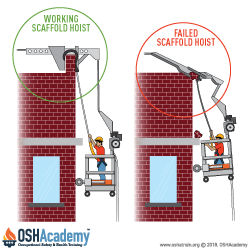Inspecting Hoists
A hoist is a mechanical device used to raise or lower a suspended scaffold. It can be mechanically powered or manually operated. When inspecting hoists check each of the following:
- Verify the stall load of the scaffold hoist does not exceed 3 times its rated load.
- When winding drum hoists are used and the scaffold is extended to its lowest point of travel, ensure there is enough rope to wrap four times around the drum.
- When other types of hoists are used, make sure the suspension ropes are long enough to allow the scaffold to travel to the level below without the rope end passing through the hoist, or else make sure the rope end provides a means to prevent the end from passing through the hoist.
- Make sure power-operated and manual hoists have been tested and listed by a qualified testing laboratory.
- Ensure gasoline-powered hoists are not used on suspension scaffolds.
- Check gears and brakes of power-operated hoists used on suspension scaffolds to make sure they are properly enclosed.
- In addition to the normal operating brake, make sure that both power-operated and manual hoists have a braking device or locking pawl which engages automatically when a hoist experiences:
- instantaneous change in momentum
- accelerated overspeed episode
- Verify manually operated hoists have a positive crank force to descend.
Many scaffold failures occur early in the morning, after condensation has collected on the wire ropes overnight. The preferred industry practice at the beginning of a shift is to raise the scaffold 3 feet, hit the brakes, then lower the scaffold and hit the brakes again. This ensures that moisture on the wire rope will not allow it to slip through the braking mechanism, causing the scaffold to fall.
Failed Scaffold Hoists Cause Worker Death
Three workers were on a two-point suspension scaffold rated at 500 lbs. working weight. As the employees went up in the scaffold, the right side fell to the ground from an elevation of 20 feet. One worker managed to hold on, the other two fell with the scaffold, resulting in one worker dying and the other being hospitalized for extensive injuries. Investigation indicated that the scaffold motor assembly was improperly connected to the scaffold platform. The workers were wearing the available safety harnesses and lifelines but had not connected the lifelines.
Knowledge Check Choose the best answer for the question.
5-11. What is the preferred industry practice to help ensure that moisture on a hoist wire rope will not slip through the braking mechanism?
You forgot to answer the question!

